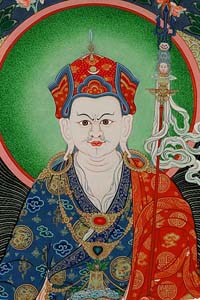
Text
Meanings
1) The Common
Hidden meaning according to:
2) The path of liberation
3) The perfection stage
4) Nyingthig of Dzogpa Chenpo
5) The accomplishment of the result
 |
|
History of The Vajra Seven-Line Prayer It is said that these lines are the prayers of invitation of Guru Rinpoche (Padmasambhāva) to the assembly of feast offerings1 by the Dorje Khadromas (Skt. Vajra Ḍākinīs). Once there came to the monastery of Nālanda heretical teachers, learned in languages and logic, who reviled the Dharma. The Buddhist scholars were unable to refute them. Then most of the scholars had the same dream. In it, Ḍākinī Zhiwa Chog (Supreme Peace) prophesied as follows: “You will not be able to defeat the heretics. If you do not invite here my elder brother, Dorje Thöthreng Tsal (Vajra Skull-Garland Power, Guru Rinpoche), who lives at the Dark Cemetery, the Dharma will be destroyed.” “How can we invite him when it is so difficult to go there?” asked the scholars. The Khadroma said: “Set up a great offering on the roof of the monastery, with music and incense, and with one voice recite the vajra prayer.” And she gave them The Vajra Seven-Line Prayer. The scholars prayed accordingly, and in an instant Guru Rinpoche came miraculously from the sky. He presided over the Buddhist scholars and defeated the heretical teachers by means of textual reference and intellectual reasoning. When he was threatened by the magical powers of the heretics, he opened the casket given him by the Lion-Faced Ḍākinī, and he found in it the mantra of “fourteen letters.”2 By reciting it, he eliminated the evil ones among the heretics with a rain of lightning bolts. He caused the remaining ones to enter the Dharma. It is said that the prayer originated from that incident. Later on, when Guru Rinpoche came to Tibet in the eighth century, he gave it to the king and his subjects. Intending it for future disciples capable of training, he concealed it in many gTers3. Later, The Vajra Seven-Line Prayer was revealed in the gTers of most of the one hundred great gTertons of the last ten centuries of the Nyingma lineage, again and again, as the heart of the prayers, teachings, and meditation.
1The Assembly (tshog’ khor) comprises rigdzins (Skt. vidyādhāras), siddhas, pawos, (Tib. dpa’ bo, Skt. Ḍākas, Heroes), and khadromas (Tib. mkha’ ’gro ma, Skt. Ḍākinīs) 2AH KA SA MA RA TSA SHA TA RA SA MA RA YA PHAT. 3Earth or mind treasures. |